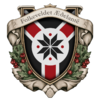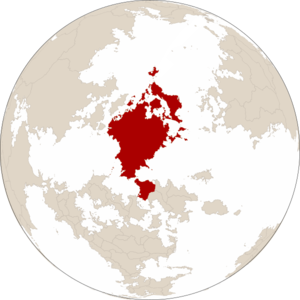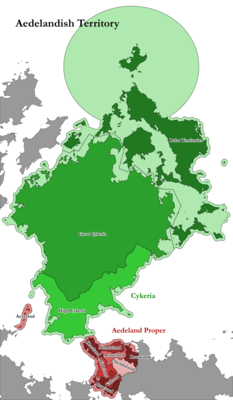Aedeland: Difference between revisions
| Line 145: | Line 145: | ||
This hierarchical representation system ensures that decision-making reflects the wisdom and experience of the elders, while also incorporating a broader base of community representation. It is a distinctive feature of Aedeland's governance, blending traditional gerontocratic principles with a structured democratic process. | This hierarchical representation system ensures that decision-making reflects the wisdom and experience of the elders, while also incorporating a broader base of community representation. It is a distinctive feature of Aedeland's governance, blending traditional gerontocratic principles with a structured democratic process. | ||
=== Provinces === | |||
[[File:Path953.png|thumb|400x400px|Political Divisions within Aedeland, including sea territorial claims]] | [[File:Path953.png|thumb|400x400px|Political Divisions within Aedeland, including sea territorial claims]] | ||
{| class="wikitable" style="margin: 0 auto;" | {| class="wikitable" style="margin: 0 auto;" | ||
|+ Provinces of Cykeria | |+ Provinces of Cykeria | ||
| Line 160: | Line 159: | ||
| Aemeland || || Ljósavatn || XXX,XXX || | | Aemeland || || Ljósavatn || XXX,XXX || | ||
|- | |- | ||
| Nordaland || || Bláfeldur || XXX,XXX || | | Nordaland ||[[File:2cc38759-46fa-448f-b03a-e8b73ac57583.png|frameless|100x100px]] | ||
| Bláfeldur || XXX,XXX || | |||
|- | |- | ||
| Alsaeland || || Ærilar (Largest city) || XXX,XXX || | | Alsaeland || || Ærilar (Largest city) || XXX,XXX || | ||
| Line 176: | Line 176: | ||
| High Cykeria || || Grænaborg || XXX,XXX || | | High Cykeria || || Grænaborg || XXX,XXX || | ||
|- | |- | ||
| Great Cykeria || || Bjargmundur || XXX,XXX || | | Great Cykeria || [[File:Rect2827.png|frameless|100x100px]]|| Bjargmundur || XXX,XXX || | ||
|- | |- | ||
| Polar Territories || || Frostahöfn || N/A || N/A | | Polar Territories || || Frostahöfn || N/A || N/A | ||
Revision as of 00:21, 4 December 2023
| Republic of Aedeland Folkeveldet Æðelantë | |
| Flag | Coat of arms |
|---|---|

|

|
| Motto: Det er Vinds vilje "That is Vind's Will" | |
| Anthem: Úrðr stýrir um hvar Fate rules over everywhere (Stoldavic) | |
| Locator map | |

| |
| Capital city | sample_city |
| Largest city | Ålesund |
| Official language | Aldsegian |
| Other languages | |
| Ethnic group | |
| Religion | Sunna Orkanan |
| Demonym(s) | Aedelmen, Aedelish |
| Government | |
| Government Type | Unitary republic |
| Fører | Adam Bjorksen |
| Lord Martial | Hjalmar Mikilsen |
| Legislature | Alþingi Lögrétta Folkmot |
| Establishment | |
| Aldsegian Rising | 7XXX |
| Area | |
| Total | xxx km2 |
| Water % | xxx |
| Population | |
| Total | xxx |
| Density | xxx/km2 |
| Economy | |
| Economy type | Market capitalist, semi-Mutualist |
| GDP (total) | Ꞡ TBA |
| GDP per capita | Ꞡ TBA |
| Currency | Standarværdi (≡) () |
| Inequality index | TBA |
| Development index | TBA |
| Other information | |
| Time zone | +0 |
| Driving side | right |
| Calling code | +TBA |
| Internet code | .adl |
From Old Æðelish "Æðel" and "Lantuð" meaning "The Lord's God Land" or "Where One Stands with the Lord." Exonym: Aedeland.
History
- Main article: Timeline of Aedeland
Founding and Early History
- Aedeland was consolidated under its current constitution shortly after the defenestration of Östervallen. This event marked a significant turning point in Aedeland's history and was instrumental in the collapse of the Greater Stoldavic Empire.
Pan-Anarian War and Expansionism
- In April 7498, a pivotal event occurred with the sinking of the Aedelish flagship Sørland. This event precipitated Aedeland's involvement in the Pan-Anarian War.
- During the Pan-Anarian War, Aedeland entered a period of aggressive expansionism and embraced Pan-Aldsegianism, a political ideology or movement that emphasized the unity and expansion of Aldsegian peoples and culture.
Key Annexations and Political Maneuvers
- In 7518, as part of its expansionist policy, Aedeland annexed neighboring Western Hagen.
- In 7526, Aedeland increased its control over Tauruæs and the Bualé Republics. This expansion was carried out quietly and was significantly influenced by operatives from the Suørtarnland Company, a powerful and influential entity in Aedeland's political landscape.
- The 7536 Declaration of Supremacy marked the political annexation of Aldsegian populations in Cykeria and Achilleio, further extending Aedeland's influence and control in the region.
Late 7500s - Attempts to Access the Phasian Ocean
- Aedeland made several attempts to access the Phasian Ocean, a strategic and economically significant body of water. These attempts included:
- A failed effort to establish a heavy air route over Tharna.
- An expedition to the interior of Tzeraka, which ultimately failed to establish a navigable route to the Phasian Ocean.
- Recognizing the limitations of these efforts, Aedeland focused on establishing an overland rail route to access the Phasian Ocean. This led to a controversial military campaign against the Ithreni-controlled West and Central Haniyyahs.
- The Suørtarnland Company, acting discreetly to avoid domestic opposition and constitutional obstacles, organized and financed a military operation using voluntary forces of the Væringet.
- East Hiniyyah, which harbored strong anti-Ithreni sentiment, was peacefully brought under control. Dhiraar Al-Azwar, a puppet of the Company, signed the Treaty of Port Amir in 7577, ceding authority to the Company.
- The conflict with Ithren over West Haniyyah remains ongoing, highlighting the continued tension and struggles for territorial control in the region.
- In 7574, Aedeland sponsored the Straits Cartel Treaty of Ærilar. This treaty was designed to monetize control over major straits, imposing tariffs and controlling maritime traffic.
- However, the tariff was met with protests from non-signatory nations, leading to a two-year non-enforcement period to reassess the implementation and enforcement of the tariff.
- The treaty's passage and its subsequent challenges led to the assassination of its architect, Jakob Av Varung.
- Following the Anisoran government's circumvention of the treaty through a flag of convenience policy, the 7579 Protocols of Gadalhem reaffirmed the Cartel's ambitions, albeit after facing what was seen as a betrayal by Anisoran allies.
Collapse of the Aldgesian Empire
Reconstitution of Aedeland
Geography of Aedeland
Aedeland is located at the northern extreme of Anaria, encompassing the western third of Stoldavia. This strategic position places it at the crossroads of various seas: to the west lies the Straits of Andlát and the Thuaid Sea, also known as Vestsjøen or the Western Sea, while to the north is the Nordsjøen or Dlreukv Sea. Its eastern borders are shared with Vittmark and the XXX, creating a diverse geopolitical neighborhood. The Zeeängten and the Narrow Sea separate the southern part of Aedeland from Hallis, and the Straits of Andlát distinguish it from Cykeria to the west.
Topography and Natural Landscape
Aedeland's topography is characterized by its remarkable diversity and heavy glaciation. The northern region is dominated by fertile steppes, offering expansive agricultural opportunities. In stark contrast, the central part of Aedeland is known for its high plateaus and rugged mountain ranges, largely undeveloped and wild. These mountains give way to deep valleys and rugged coasts along the western border, adding to the dramatic natural scenery.
One of Aedeland's most famous geographical features is its rugged coastline, intricately carved with deep fjords. These fjords, a result of glacial activity, have shaped the country's coastal landscape, creating spectacular natural harbors and breathtaking scenery. The presence of these fjords has also influenced the country's culture and history, often being featured in local folklore and mythology.
In contrast to the rugged central and western regions, the southern coast of Aedeland boasts fertile plains. Though fewer in number, these plains are known for their agricultural productivity. Fertile valleys, which crisscross the country, further enhance the agricultural potential of the region, acting as natural conduits for trade and communication between different parts of the country.
Highest Point
Mestrhorn stands as the highest point in Aedeland, a symbol of the country's diverse and imposing natural landscape. This peak, likely a part of the central mountain ranges, adds to the country's rich topographical diversity, offering a stark contrast to the fertile plains and deep fjords.
In summary, Aedeland's geography is marked by its varied landscapes, from fertile steppes and plains to rugged mountains and coastlines, all interconnected by fertile valleys and highlighted by the famous fjords. This diverse geography not only shapes the country's natural beauty but also influences its climate, ecosystems, and human activities.
Political Geography of Aedeland
Regional Governments and Local Assemblies Aedeland's political landscape is characterized by regional governments, known as Adl Lægrivöld, which consist of various local assemblies. Each of these assemblies operates under its own constitution, offering a glimpse into the diverse political fabric of the nation. While some of these local assemblies practice democracy, most adhere to the Hérauð system, a unique form of governance resembling a gerontocracy. In this system, elders play a pivotal role, often selecting themselves or their representatives for political positions. The elder member of each family chooses a representative for the Ætt, and these representatives then elect their members to the Hérathing. This process continues up the hierarchy to the higher Úbeing and ultimately to the Lögrétta, illustrating a complex and layered political structure.
Cultural Geography of Aedeland
The Buálé Culture Predominantly found in Nordaland and Valland, the Buálé culture is known for its strict, hardworking farm lifestyle and puritanical interpretation of the faith. This group is easily identifiable by their distinctive black, plain dress. They exemplify a culture deeply rooted in agricultural traditions and religious conservatism.
Hárfólk and Víkingur Cultures In Haraland and Skoldaland, the Hárfólk and Víkingur cultures are nearly indistinguishable, with a common origin story suggesting that the Hárfólk were founded by Víkingurs who retreated to the highlands to escape the authority of the Mormuärs of Storhavn. Both groups have adapted to life on challenging and less fertile soils, forging a rugged existence. Their culture is marked by a rough style of dress, favoring coarse wool, fur, and deerskin, and they are known for their crudeness, infighting, and rebellious nature.
The Alsuæ Culture Found almost exclusively within Alsaeland and southern Skoldaland, the Alsuæ represent the most metropolitan of Aedeland's subcultures. The urban population in Alsaeland, which wields significant cultural influence in Aedeland, has been heavily influenced by foreign cultures, particularly from central Anaria via Achilleio and Thultannia. In contrast, the rural Alsuæ maintain more traditional cultural elements with less pronounced foreign influence. Their elaborate folk dress, often featuring colorful embroidery, scarves, bonnets, and shawls, is a notable aspect of their identity.
The Ayren Culture Located in the southern state of Mildeland, the Ayren culture is a liberalized variant of the northern Buálé. Blessed with mild weather and fertile soil, the Ayren are known as idyllic agriculturalists with a Provençal disposition. This culture contrasts with the more austere Buálé, reflecting the influence of their more temperate and prosperous environment.
Government and Politics
Aedeland functions as a constitutional confederated republic, underpinned by a decidedly limited national government. This government forms part of a complex hierarchy of overlapping and competing regional governments. The structure and function of Aedeland's government reflect a deep-seated belief in the protection of individual rights and properties, as espoused by the lawgiver Guðfriður Hinn Guttlausi.
Legislature
The Althing At the heart of Aedeland's national government is the bicameral legislature known as the Althing, comprising two distinct bodies:
- Council (Lögrétta): This aristocratic and deliberative parliament is responsible for formulating and passing legislation. It consists of 101 aldermen, also known as Jarldomen (meaning chief men), who are seen as the eldest and wisest members of society. These aldermen are selected every five years by regional party leaders through staggered proportional elections within each senior regional assembly (Úbeingi) of the six Lantðabn. Seat apportionment among the Lantðabn is based on population, determined by a census conducted every seven years during the 'Release Year' (Frihetsåret).
- Assembly (Folkmødt): This democratic and auditory body is tasked with reviewing legislation and overseeing government operations. Members, known as Nefndarmen, are popularly elected in staggered elections for two-year terms. The Assembly, comprising 320 members, each represents approximately 5,000 individuals, as determined by the last census. The Folkmoot holds the power to veto laws passed by the Council, declare laws unconstitutional, and impeach officials, including aldermen, judges, the leader, or cabinet ministers.
National Leadership and Executive Cabinet
- The national leader, elected by the Upper Council, appoints an executive cabinet consisting of three secretaries: War, Foreign, and Home.
- The current elected leader of the Althing is Georg av Horda, assisted by three appointed cabinet ministers: Lord Martial Severin av Skálholt, Foreign Secretary Vilhelm av Húlarung, and Home Secretary Eiríkr av Ödlanding.
- This leadership structure emphasizes a balance of power between the elected representatives and the appointed officials, ensuring a check-and-balance system within the government.
Electoral and Political Process
- Members of the Upper Council are appointed by regional assemblies, while members of the Lower Assembly are elected through popular vote.
- The electoral process is unique in that only fathers of adult children are eligible to vote for representatives to the assembly.
Political Geography
The provincial governments in Aedeland, known as Adl Lægrivöld, are characterized by a diverse array of local assemblies, each operating under its own unique constitution. This structure reflects the varied political and administrative landscapes across the provinces, allowing for a degree of local autonomy and governance that aligns with the specific needs and traditions of each area.
Democratic and Gerontocratic System
While some of these local assemblies function as democracies, a majority operate under the Hérauð system. The Hérauð system is notable for its gerontocratic nature, where governance is predominantly in the hands of elder members of the community. This system values the experience and wisdom of the older population, entrusting them with key decision-making responsibilities.
Election and Representation Process In the Hérauð system, the election and representation process unfolds in a multi-tiered manner:
- Family-Level Selection: The elder member of each family selects a representative to the Ætt, a foundational unit in the local governance structure.
- Ætt to Hérathing: Members of the Ætt then elect their representatives to the Hérathing, a larger assembly that encompasses a broader segment of the community.
- Higher Levels of Governance: These representatives, in turn, elect individuals to the higher Úbeing, continuing the chain of representation and governance. This process culminates in the selection of representatives for the Lögrétta, the uppermost level of the provincial governance structure.
This hierarchical representation system ensures that decision-making reflects the wisdom and experience of the elders, while also incorporating a broader base of community representation. It is a distinctive feature of Aedeland's governance, blending traditional gerontocratic principles with a structured democratic process.
Provinces

Cykeria
Aedeland has undergone significant territorial changes, with Cykeria now standing as its primary and largest province in terms of area. Situated on the Jorveh continent north of Anaria, Cykeria represents a strategic expansion of Aedeland's territory. This expansion includes the entirety of the Arctic islands and the full extent of the Arctic ice cap, as defined by its maximum reach in 7610. Historically a colony, Cykeria's status has evolved, integrating it more fully into Aedeland's provincial framework. Despite its vast area, it remains the least populated province in Aedeland, offering a unique blend of expansive territory with low population density.
Cykeria's significance to Aedeland extends beyond its geographical expanse. The province is blessed with exceptionally large mineral deposits, which have become a major boon to both the Aedelish economy and the national budget. The wealth of natural resources found here includes lead, cobalt, iron, platinum, and gold. These deposits are not only abundant but are also among the highest quality and most accessible to Anarian industry. The proximity of these resources to major industrial centers in Anaria makes extraction particularly lucrative, positioning Cykeria as a key player in Aedeland's economic landscape.
As Aedeland taps into Cykeria's rich mineral resources, there is an emerging focus on balancing economic growth with sustainable mining practices. The challenge lies in harnessing these resources in a way that minimizes environmental impact, particularly in such a sensitive and pristine Arctic region.

